| |
It’s amazing what a difference just over two million years makes compared geographically to your nearby sibling. Kaua’i, near the northern end of the inhabited Hawai'ian Islands, is serene in a foundation carved by water and time and cloaked in a mantle of lush foliage. O’ahu, 63 miles to the southeast, is a bustling metropolis and headquarters of America’s military presence in the Pacific.
Thirty miles south of O’ahu, Maui finds travelers maneuvering 59 narrow bridges and 617 hairpin turns along the Hana Highway, and surfers testing their mettle on 60-foot-plus waves at Jaws (aka Pe’ahi). Just 26 miles beyond sits the youngest member of the family - 4.5 million years younger than Kaua’i - the Island of Hawai’i, best known for its five volcanoes including snow-dusted Mauna Kea and fiery Kilauea, spouting forth pretty much nonstop since 1983. These specks of land could hardly be more different from each other but there are similarities among the eight inhabited islands of this 3,600-mile long seamount. Encompassing 107 volcanic mountains and 132 reefs, shoals and islands, all of them were born from the Hawaiian Hot Spot in the middle of the Pacific Ocean that currently fuels Kilauea. The Jeiji Seamount was first to form 82 million years ago, its current location near the western end of the Aleutian Islands in Alaska a testament to the northwestern movement of the Pacific Tectonic Plate.
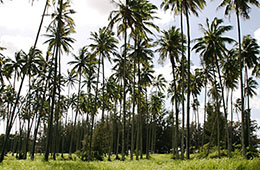 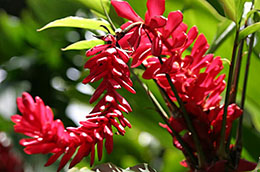 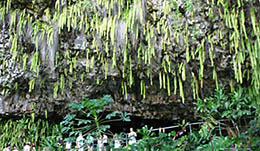
The Royal Coconut Grove (left) extends for ten acres along Waipouli Beach near Kapa’a. Nestled into a natural amphitheater along the Wailua River, it is easy to see how the Fern Grotto (right) got its name.
All the Hawai’ian Islands are indescribably beautiful and share the captivating Polynesian culture, but each offers a distinctive personality, unique experiences, and different reasons to visit. When asked which is my favorite or which I recommend, I do not have a ready answer. Most folks who have been to Hawai’i either have a definite favorite
or can’t begin to single out just one, and I tend toward the latter. “Why” you should visit our 50th State was revealed
in “Hawai’i: Ten Reasons WHY” (highonadventure.com/hoa16jul/vicki/why-Hawai’i.htm): Incredible Geology, Tumultuous History, Distinctive Culture, Implausible Beauty, Unique Endowments, Endless Adventure, Aloha Spirit, The Weather, It’s Uncomplicated, and the Legends. Now we’ll delve deeper into each island and explore what it offers, starting with the oldest of the main islands, Kaua’i.
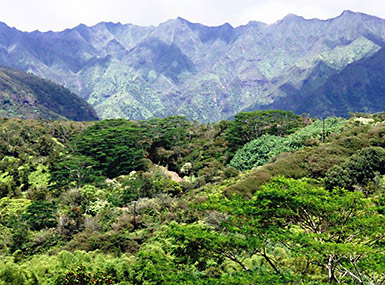
Kilohana Crater sits on the eastern flank of 5,243-foot Kawaikini Peak, Kauai’s tallest point
Long known as the Garden Island for its lush vegetation, Kaua’i is the third-most visited Hawai’ian island and most appreciated for its small towns, laid-back atmosphere, wellness and spiritual-oriented opportunities, and geologic wonders. Twenty-five miles long and 33 miles wide, it is the fourth largest of the main islands and about the size of Guam or St. Lucia. Only 3% of the land has been developed, and buildings are capped at four stories tall, the height of a coconut palm. A population of 67,000 includes about 11,000 living in Kapa’a and 6,500 in Lihu’e, the island’s commercial center, main airport and harbor.
| |
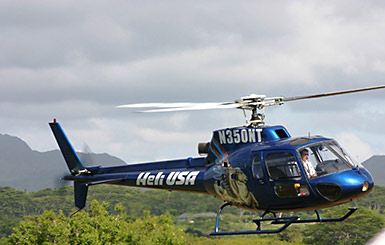 |
|
My first suggestion when visiting Kaua’i is to find someone to give you the bird…as in a whirlybird tour. Only 10% of the island is accessible by vehicle and a bit more via hiking trails, so a helicopter provides close-up views of stunning waterfalls, amazing coastlines, deep into Waimea Canyon, and other places you’d otherwise never see. |
|
| |
Kauai helicopter |
|
|
|
Some locations may bring a sense of déjà vu given that nearly 80 major motion pictures and television shows have filmed on the sandy beaches, in the lush rainforests, and among the stunning geographical phenomena of Kaua’i. Most famous might be Elvis Presley’s Blue Hawaii, and most dramatic might be Jurassic Park, which included actual footage from Hurricane Iniki that hit the island during filming.
After leaving her home in the South Pacific, legend says the fire goddess Pele first tried to make her home on Kaua’i, but every attempt to dig a fire pit was defeated by water. She finally moved on to the younger Island of Hawai’i where her volcanic fury can still be experienced. What stymied Pele was an island that, over time, both eroded into a 3,500-foot-deep canyon ten miles long by two miles wide, and sculpted into a mountain so tall it captures nearly 38 feet of rainfall a year, making it the wettest spot in the US and one of the most drenched locations on the planet. No wonder Pele’s fires wouldn’t burn.
The Waikanaloa (left)and Waikapala’e Wet Caves near Ha’ena on the North Shore are said to be
among Pele’s failed attempts to dwell on Kaua’i. Smack dab in the center of the island, Mount
Wai’ale’ale (right) snatches moisture-rich air moving across the Pacific, funnels it into more
waterfalls than can be inventoried and nurtures a vast ecosystem.
Archaeologists believe Kaua’i was first populated around 200 CE, a half-millennium before the other islands, by Polynesians from Tahiti, Samoa and the Marquesas. Kaua’i and neighboring Ni’ihau were the only Hawai’ian islands never conquered by King Kamehameha I, but conceded into the Kingdom after the death of the last Kaua’i chief in 1810.
| |
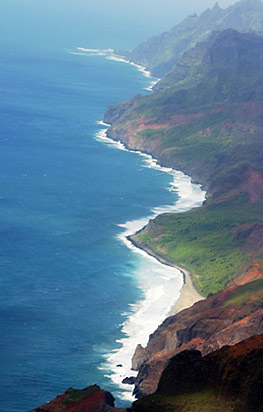 |
|
The first settlements may have been established along the Na Pali coast (left), with the Nu’alolo Kai State Park site particularly rich in cultural and archaeological material, well-preserved and protected by the sheer drop needed to reach the valley by land. Ancient home sites, taro patches and sacred places are tucked away in Hanapepe Valley, while McBryde National Tropical Botanical Garden includes ancient stone walls, taro beds, and a lokoi’a or fish pond. At the mouth of the Wailua River in Lydgate State Park, two more large lokoi’a are evidence of early Hawaiian aquaculture. |
|
A 13-acre cultural site known as the Kaneiolouma Complex is currently undergoing restoration near Po’ipu. A sacred site and significant historical landmark, it holds evidence of nearly 600 years of habitation including remnants of homes, taro fields, fish ponds, altars and other trappings of community life. Kamokila Village, an ancient fishing and farming village on the banks of the Wailua River, now showcases various structures built in the old Hawaiian style. Rock walls scattered throughout Waimea Canyon are more evidence of early settlements.
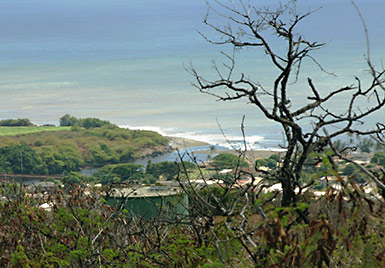
Waimea Bay
When Captain James Cook arrived in the Hawai’ian Islands in 1778, his first landfall was at Waimea Bay (above) on the southwestern shore. Traditionally credited with being the first westerner to “discover” this archipelago, there is good evidence he was not the first (see the sidebar “European Discovery” in my article “Hawai’i: Ten Reasons WHY”). He is responsible for mis-naming them the Sandwich Islands for his sponsor, the Earl of Sandwich, a moniker that stuck until the 1840s when the local designation “Hawai’i” became more widespread.
| |
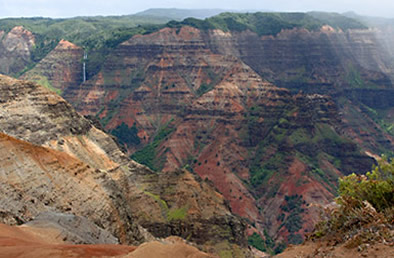 |
|
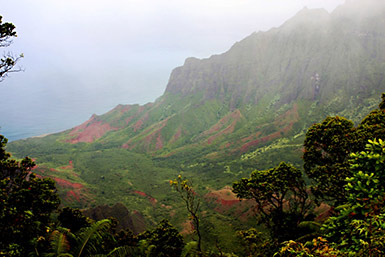 |
|
Waimea Canyon (left) from the Waimea Canyon Lookout, and Kalalau Valley (right) on the Na Pali Coast from Pu’u o Kila Lookout, Koke’e State Park.
Scenes from Honeymoon in Vegas, Donovan’s Reef, Wackiest Ship in the Army, Lilo & Stitch and the Fantasy Island show were filmed in Waimea Canyon. The Kalalau Valley was inhabited until 1919 but is so inaccessible it can only be reached by boat or a rock-strewn hike, but its beach appears in King Kong, Mighty Joe Young and Lilo & Stitch.
Mark Twain is credited with christening Waimea Canyon the “Grand Canyon of the Pacific”, but he never actually saw it because he never visited Kaua’i during his travels in Hawai’i. When a fault line split the island, water cascading from Mount Wai’ale’ale’s sodden summit engraved deep gorges into the volcanic rock. Over time, groves of trees and other native flora took hold, with 90% of Kaua’i’s native flowers not found anywhere else. The 1,866-acre Waimea Canyon State Park overlooks the Waimea River - colored a smudgy brown from decaying plants - and vast canyons painted every earth-toned hue nature could throw at them.
Koke’e State Park’s 4,345 acres of upland wilderness begins around mile post 16 on Waimea Canyon Drive. It’s populated by black-tailed deer introduced from Oregon in the 1960s, goats left by George Vancouver in the 1790s, and pigs brought by the early Polynesians. Nearly 45 miles of trails access other Waimea Canyon and Na Pali Coast viewpoints, and a boardwalk over part of the 20-square-mile Alaka’i Swamp where most of Mount Wai'ale’ale’s water collects before plunging into countless waterfalls and streams.
All that water contributes to the “Garden Isle” nickname and there are many island locations to seriously explore Kaua’i’s flora. Of five National Tropical Botanical Gardens (NTBG) in the world, four are in Hawai’i and three of those on Kaua’i. The 1,000-acre Limahuli NTBG & Preserve on the North Shore is one of the few remaining native forests in Hawai’i and is home to 38 species of endangered endemic plants. In the Lawa’i Valley, research is conducted on more than 6,000 tropical species at the 252-acre McBryde NTBG, while the adjacent Allerton NTBG works to conserve native flora. In the foothills near Kapa’a, trails at the Keahua Arboretum wind beneath a canopy of monkeypod, eucalyptus and mango trees, and alongside streams and ponds. The Botanical Gardens provided the perfect tropical setting for scenes from Castaway Cowboy, Donovan’s Reef, Honeymoon in Vegas, Jurassic Park and South Pacific.
| |
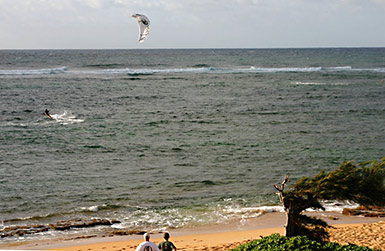 |
|
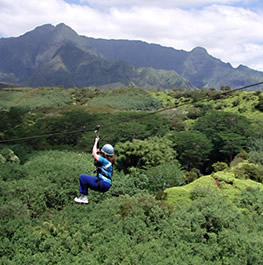 |
|
| |
Waipouli Beach kite sailor |
|
Zipline |
|
Kaua’i has also earned the well-deserved designation “Island of Discovery.” Visitors find infinite water-based offerings including surfing and paddleboarding, snorkeling and diving, windsurfing and parasailing, kayaking, and just plain old fun-in-the-sand-and-surf. Innertube through former sugar plantation irrigation ditches, zipline above streams and forest canopies, explore the backcountry by horseback or ATV, visit endless movie locations, whack balls around one of the island’s ten golf courses, hike into seldom-visited valleys, or unravel a 5-million-year-old geological record that may hold the richest hoard of fossils in the Pacific. Kaua’i presents an array of places and things to discover and ways to do so.
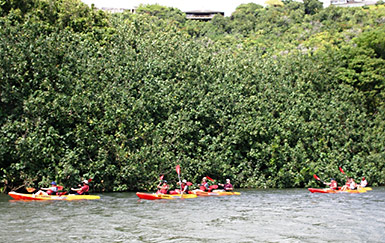
Kayakers explore the Wailua River
Originating in the crater of Mount Wai’ale’ale and fed by a number of streams, the Wailua River is one of only three navigable rivers in the Hawai’ian Islands, all of them on Kaua’i. Considered so sacred that seven heiau (temples) once stood along its banks, Wailua River State Park includes over 1,000 acres encompassing a number of archeological sites. At the River’s mouth, ancient petroglyphs are discernible when enough rain clears away the sand. Rumor says that during the American Civil War, a Union ship slipped up the Wailua River to hide from the Confederate vessel Shenandoah that was involved in an attempt to topple the whaling industry in the region. The river appears in a number of movies including Blue Hawaii, Donovan’s Reef, The Hawaiians, Islands in the Stream and Jurassic Park III.
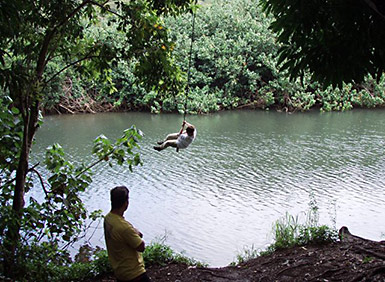
ATV tours on Kipu Kai Ranch include the location where, in the opening scene of Raiders of the Lost Ark, Indiana Jones made a rope-swinging escape to his float plane, anchored in the Hule’ia River.
Other movies filmed on the property include Outbreak, The Hawaiians , The Descendants with George Clooney, and Diamond Head (yes, despite the movie’s title, the plantation manager’s home Charlton Heston’s character inhabited is actually part of Grove Farm which is located on the Ranch. The river also played a part in The Time Machine and To End All Wars.
Another of Kaua’i’s navigable rivers, the Hule’ia River runs through Kipu Kai Ranch, a 3,000-acre former sugar plantation-turned-cattle-ranch. Near the eastern terminus is the 39-acre Menehune Fishpond, so named because legend places its construction around 1,600 years ago by the Menehune, a small race known for their engineering feats.
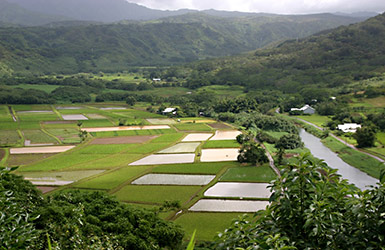
Hanalei Valley taro fields
Kaua’i’s third navigable river is the Hanalei, named one of 14 American Heritage Rivers. Just 16 miles long, it irrigates 200 acres of loi or taro fields, producing nearly three-quarters of Hawai’i’s supply – over five million pounds a year -- on 200 acres in the mile-wide by six-mile-long Hanalei Valley. The taro farms appear in the movie Lilo & Stitch and the Valley’s Power Line Trail used in Jurassic Park III.
| |
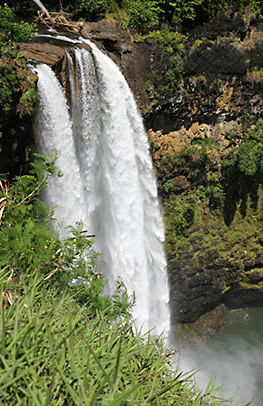 |
|
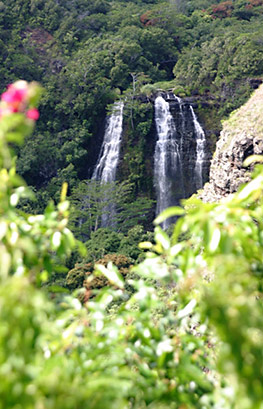 |
|
| |
Wailua Falls |
|
Opaeka'a Falls |
|
Most of Kaua’i’s waterfalls are hidden in verdant valleys beyond vehicle access and most unreachable by foot. Plunging 80 feet over a cliff the Hawaiians used as a diving platform, Wailua Falls (above left) starred in the opening scene of the Fantasy Island TV series, the movies Fantasy Island and Dinosaur. The river at the bottom of Opaeka’a Falls (above right) plummeting cascades once teemed with shrimp, and found its way onto the big-screen in Blue Hawai’i and Wackiest Ship in the Army.
| |
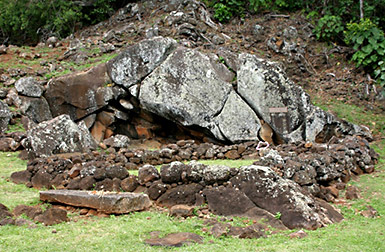 |
|
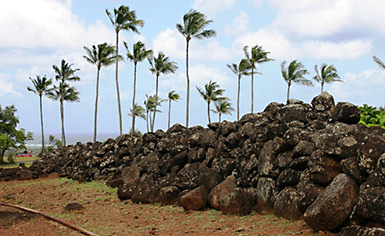 |
|
| |
Holoholoku Heiau Pohaku Hoohanau Birthstone |
|
Poliahu Heiau |
|
Sites sacred to the ancient Hawaiians, known as heiau (see sidebar), can be found all over Kaua’i, but the Wailua Heiau Complex is perhaps the most significant. Spread along the bluffs above the Wailua River, it includes the Holoholoku Heiau royal birthing site with the Pohaku Ho’ohanau Birthstone (above left), one of only two royal birthing stones in Hawai’i. It was of utmost importance for a high chief’s wife to give birth here to ensure the child was blessed with rank and privilege. Sacrifices were performed at Poliahu (above right), the largest remaining heiau on Kaua’i.
Built more than a thousand years ago on a point near the mouth of the Wailua River, Hikinaakala Heiau is the first place on Kaua’i to receive the light of the morning sun. Carved images once stood guard where the river empties into the ocean. Nearby Hau’ola o Honauau was a Place of Refuge. If someone violated a kapu or law, they could redeem themselves if they were able to reach a Place of Refuge, make an offering, and receive atonement from a kahuna or priest.
For nearly a thousand years hula practitioners have come to a grassy terrace above Ke’e Beach on the North Shore, where they learned to perfect their art at the Keahu o Laka Heiau. Students still come to test their skills and pay homage to Laka, goddess of hula.
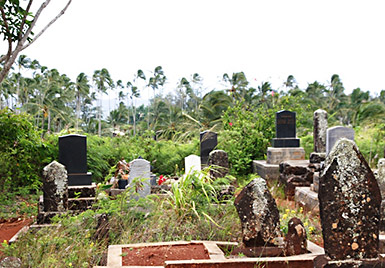
Japanese cemetery above Holoholoku Heiau
Many other cultures and beliefs have left their mark on Kaua’i. A small Japanese cemetery (above) sits in silent contemplation above the Holoholoku Heiau. Temple carpenters from Japan constructed the Jodo Mission in Koloa, with inlaid hand-painted ceiling tiles gifted by Japanese artists. Recreating a pilgrimage route on Shikoku Island, Japan, the Lawa’i International Center features 88 Buddhist shrines winding up a steep pathway to the location of an ancient healing heiau. One of the world’s most important Hindu holy sites is the Aadheenam Hindu Monastery with a temple that includes 108 gold-leafed statues of Shiva and a panoramic vista of the Wailua River.
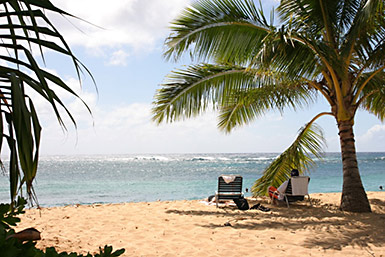
Poipu Beach
Kaua’i has more beaches per mile of shoreline than any other Hawai’ian Island. Consistently ranked among the world’s “top beaches,” Po’ipu (above) offers the perfect mix of grassy lawn fronted by palm-shaded sand accessing a beach with great swimming, a shallow section for the kids, and some interesting snorkeling and diving areas. Nearby Brennecke Beach is the hotspot for body-surfing on Kaua’i.
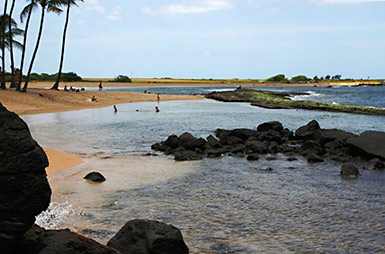
Near Hanapepe, the tide pools at Salt Pond Beach are the last place
in Hawai’i
where sea salt is still harvested in the traditional manner.
A good location for snorkeling beyond the natural lava rock barrier,
this beach is also notable for some of the island’s best windsurfing.
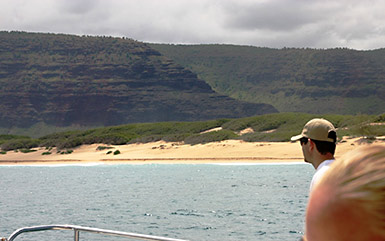 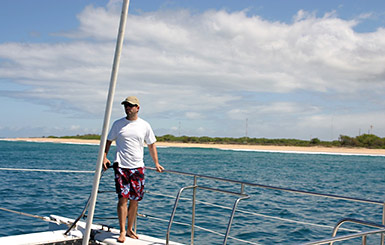
A 15-mile expanse of remote shoreline, Barking Sands Beach and Polihale Beach State Park make up Kaua’i’s longest beach. The large grains on Barking Sands (above right) make a “barking” sound as they stir in the wind. At the northern end is Polihale Beach (above left), location of Polihale Heiau, a departure point for dead spirits.
Beyond Barking Sands/Polihale, the Na Pali coastline is a fairly inaccessible 14-mile stretch of 4,000-foot sea cliffs only visible by air or sea. Lush valleys are draped with enormous waterfalls and sea arches; caves speckle the shoreline and small remote patches of sandy beach unexpectedly materialize.
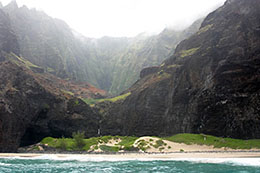 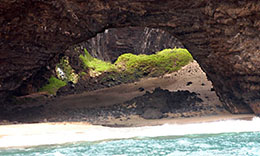 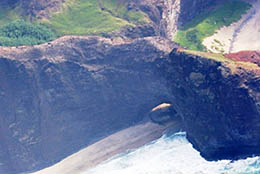
The dramatic Na Pali coast has been featured in countless movies including The Lost World: Jurassic Park and Dinosaur. In addition to Man with the Golden Gun and Pirates of the Caribbean: On Stranger Tides, Honopu Beach (above left) found Jessica Lange escaping King Kong, and Harrison Ford running away to avoid a pirate attack in Six Days, Seven Nights. At the north end of the beach the 90-foot Honopu Arch forms a Na Pali coast landmark, seen from the sea (above center) and air (above right). The Valley is sometimes referred to as “Valley of the Lost Tribe,” legendary home of the Menehune.
Hanalei’s pier was used in the movie Wackiest Ship in the Army and Hanalei's Beach in The Descendants,
South Pacific and Lilo & Stitch
Two miles of soft golden sand arcing in a half-moon along a vegetation-back-dropped cove often finds Hanalei Bay touted as one of the most beautiful beaches in the world. Calm water in the summer makes it perfect for swimming and snorkeling; agitated waves in the winter bring surfers and body-boarders. Normally an un-crowded escape, calmer water can usually be found at Waikoko Beach (right), a small slip of sand near the western end of the Bay.
| |
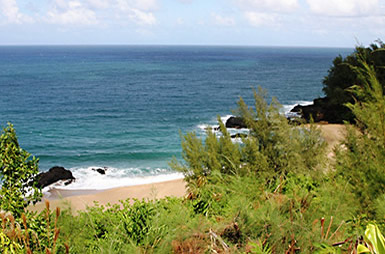 |
|
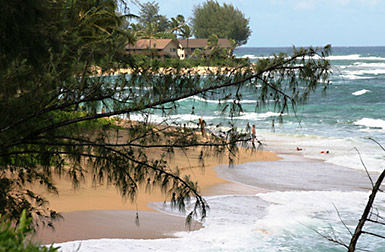 |
|
A series of inviting beaches spread out along Kaua’i’s North Shore, although most should be avoided in the winter due to strong currents and undertows. Many scenes from the movie South Pacific were filmed on Lumaha’i Beach (above left), postcard-perfect but plagued with strong currents year round. A two-mile swath of sand and a protected lagoon makes Tunnels Beach (above right) a popular spot for swimming, surfing, snorkeling and diving among underwater lava tubes (hence its name). A protected lagoon filled with fish draws snorkelers and swimmers to Ke’e Beach. Usually the safest of North Shore beaches for swimming and snorkeling, ‘Anini Beach Park is also great for windsurfing.
If you prefer your adventures by foot, you’ll be delighted to know that Kaua’i has more hiking trails than any other Hawai’ian island. Waimea Canyon’s extensive network includes Kukui Trail which descends 2,500 feet into the bottom. The Kuilau Ridge Trail from Keahua Arboretum leads along a view-packed non-motorized multi-use path. A more strenuous jaunt heads up Nounou East “Sleeping Giant” Trail for panoramic views of the island’s windward side. Near Ke’e Beach, the Kalalau Trail traverses the Na Pali cliffs rewarding the effort with secluded beaches and jaw-dropping views.
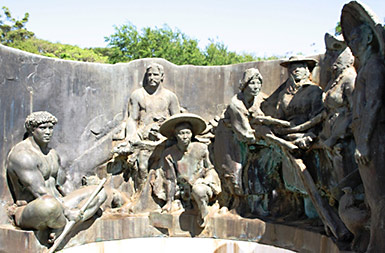
The varied ethnic groups that helped Kaua’i’s sugar industry thrive
are commemorated in this sculpture, one of 14 markers
along
the 10-mile Koloa Heritage Trail where interpretive signs
explain
significant cultural, archaeological, historical and geological landmarks.
There are no busy urban centers here but there are little jewels like Hanapepe, Kaua’i’s “Biggest Little Town,” established by Asian plantation workers and home to art galleries and shops brimming with high-quality local crafts. Once the commercial hub of Kaua’i, third largest whaling port in the islands and home to Hawai’i’s first sugar plantation, Koloa is a funky little stop whose old plantation buildings now accommodate eateries and boutiques.
Kilauea is celebrated for its Lighthouse, a National Historic Landmark built on the northernmost point of the inhabited Hawai’ian Islands, and the Kilauea National Wildlife Refuge. This is a nesting site for numerous species of seabirds and a release site for the endangered Nene goose, Hawai’i’s state bird. Foodies might like to know the small hamlet also enjoys great success with its aquaculture endeavors, and the 450-acre Guava Kai Plantation is a succulent must-see. Shopaholic or not, you will enjoy a visit to the Kong Lung Company, overflowing with unusual items from around the world in a turn-of-the-20th-century building listed on the National Register of Historic Places.
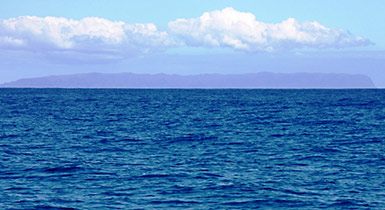 |
|
The privately owned island of Ni’ihau, oldest and westernmost of the inhabited Hawai’ian isles, sits fifteen miles southwest of Kaua’i. Known as the “Forbidden Island,” limited heli-tours are the only way to visit this 70-square-mile plot of land with no services or stores. Relatively flat and arid due to its position in the lee of water-grabbing Mount Wai’ale’ale, a visit probably isn’t on most folks’ bucket list. Ni’ihau is best known for the tiny pastel-colored Kahelelani, Laiki and Momi seashells which wash ashore a few times a year. They are then gathered and strung into lei which are so rare and valuable, they are considered insurable items of jewelry. This view is from a catamaran off the Na Pali Coast; the best land-based view is from the Pu’u Hinahina Lookout in Waimea Canyon. |
Always Popular and For Good Reason
Hanalei
Po’ipu
Waimea Canyon
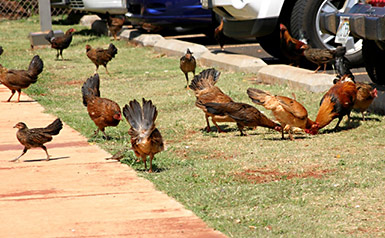
You won’t find much traffic on Kaua’i other than a slowdown
on the Kuhio Highway around Lihu’e and Kapa’a at “rush hour.”
You will come upon chicken “traffic” almost everywhere,
thanks to a couple of tropical storms that passed through
in 1982 and 1992 and turned caged birds into free-range critters.
They don’t beg, bite or stow away in your vehicle,
and are much better mannered than many visitors.
Kaua’i’s Perfect If You Enjoy
nature
in-your-face, over-the-top geology
small towns full of character and friendly locals
swimming, snorkeling, surfing, water play
ancient cultural sites
hikes with breathtaking views of nature
frequent farmer’s markets and produce stands
free-range chickens…everywhere
What You Might Miss on Kaua’i
endless nightlife
big-city cultural events
big-league sports and traffic
mega-shopping malls
gaggles of child-centric resorts
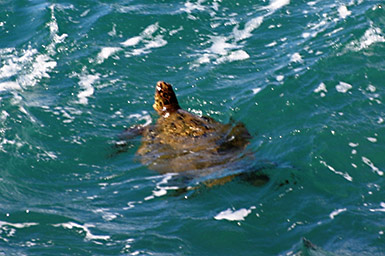
Green sea turtles, dolphins and Monk seals often frequent
the secluded coastline along the Maha’ulepu Heritage Trail
Only On Kaua’i
Imagine 10,000 years of animals and plants that, when their lives were done, became fossilized in massive sand dunes along the shore. Over time the island’s plentiful rainwater whittled out caves and a colossal sinkhole to reveal what might be the most productive fossil site in all the Pacific. The Maha’ulepu Heritage Trail on Kaua’i’s South Shore is a mere four miles “there and back again” (as Bilbo Baggins might say), but you will encounter more wonders than Middle Earth. Acidic groundwater meeting alkaline limestone perfectly preserved everything: leaves and seeds and pollen, animal bones and shells, stone tools and carved wood. Ancient offerings were made at the Heiau Hoouluia to ensure good fishing. Nearby, 67 petroglyphs are revealed with the right tidal conditions. Around Maha’ulepu Beach what appears to be a hodgepodge of rocks are actually remains of ancient home sites, fences, platforms and sacred structures. Perhaps nowhere else can be found such a rich collection of geological and botanical history, and archaeological and cultural discoveries.
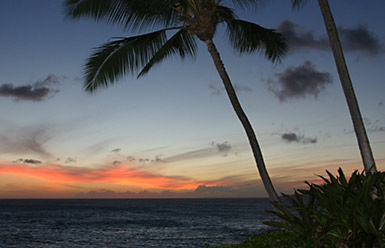
Kaua'i Sunset
Kaua’i received a tip-of-the-hat from National Geographic Traveler magazine that included the island among the “Best of World” destinations for 2017, one of only three U.S. locations and the only Hawai’ian island. Many of the venues might be familiar from the silver screen, but there is much to uncover on Kaua’i beyond the movies and the beaches, much to learn about the history of the island and the culture. The ambiance of Kaua’i allows time for reflection and will stir visitors beyond the ordinary.
411
www.Kaua’iDiscovery.com
Kaua’i Quest www.highonadventure.com/Hoa06aug/Vicki/Kaua’i6.htm
SIDEBAR: HEIAU
Heiau, pronounced hay-ee-ow, are sacred sites mostly abandoned in the later 1800s, although some are still in use. These sacred sites should never be disturbed and all offerings should be left untouched. Heiau had various purposes depending on which gods were honored. A heiau ho’ola was a healing site, heiau ho’oulu ua for rain, heiau ho'oulu 'ai for crops, heiau ho'oulu for fishing. Preparation for war often included making a luakini or sacrifice (usually human) at a heiau po'o kanaka. Heiau can be found on all the Hawai’ian Islands, some fully restored, some partially built over, and others mere hints of their past grandeur.
|
|